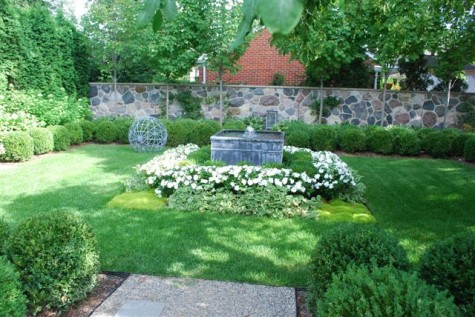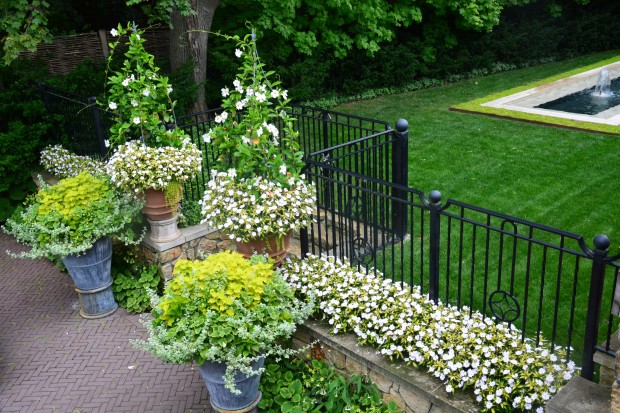 My summer driveway garden has only one flowering plant-a white sunpatiens with a variegated leaf. Lots of them. I am astonished at how well this plant has performed, given less than ideal sun, chilly temperatures, and relentless rain. The plants have grown at an astonishing rate, and shrug off troublesome weather. The Japanese beetles did not touch them-I like to think that is because they wouldn’t dare attack a plant this robust. The white mandevillea vine is not flowering profusely, but it is flowering enough to suit me. All of the other plants are various shades of green. Green plants in pots have one big visual advantage. They never look like they are missing something.
My summer driveway garden has only one flowering plant-a white sunpatiens with a variegated leaf. Lots of them. I am astonished at how well this plant has performed, given less than ideal sun, chilly temperatures, and relentless rain. The plants have grown at an astonishing rate, and shrug off troublesome weather. The Japanese beetles did not touch them-I like to think that is because they wouldn’t dare attack a plant this robust. The white mandevillea vine is not flowering profusely, but it is flowering enough to suit me. All of the other plants are various shades of green. Green plants in pots have one big visual advantage. They never look like they are missing something.
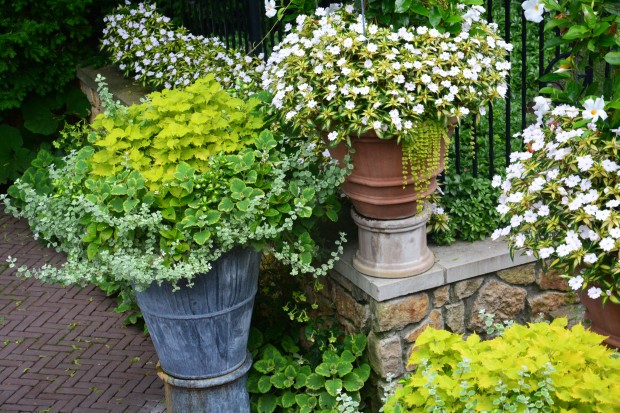 The flowering plants on my deck are making a strong comeback from the cold and torrential rains. A big pot of lilac New Guinea impatiens is budding-but is missing all of its flowers. Likewise the pots of geraniums. Both geraniums and New Guineas have beautiful foliage, but I do not grow them with that in mind. I grow them for the flowers-the color. They been missing flowers for several weeks now. The driveway garden looks perfectly happy.
The flowering plants on my deck are making a strong comeback from the cold and torrential rains. A big pot of lilac New Guinea impatiens is budding-but is missing all of its flowers. Likewise the pots of geraniums. Both geraniums and New Guineas have beautiful foliage, but I do not grow them with that in mind. I grow them for the flowers-the color. They been missing flowers for several weeks now. The driveway garden looks perfectly happy.
 These green plants took the hostile weather in stride, and have grown steadily. No rotting flower heads to contend with. Every one of the plants in these pots is a different shade of green, a different texture, and a different shape. I have not touched these pots except to water when necessary. The pots are large, and the soil is completely shaded by plants. I have watered twice in the past 2 weeks. Now that our temperatures are climbing into the 80’s, I will water accordingly. I suppose I could pinch the plants in these pots, but I am more interested to see how they will sort things out for themselves.
These green plants took the hostile weather in stride, and have grown steadily. No rotting flower heads to contend with. Every one of the plants in these pots is a different shade of green, a different texture, and a different shape. I have not touched these pots except to water when necessary. The pots are large, and the soil is completely shaded by plants. I have watered twice in the past 2 weeks. Now that our temperatures are climbing into the 80’s, I will water accordingly. I suppose I could pinch the plants in these pots, but I am more interested to see how they will sort things out for themselves.
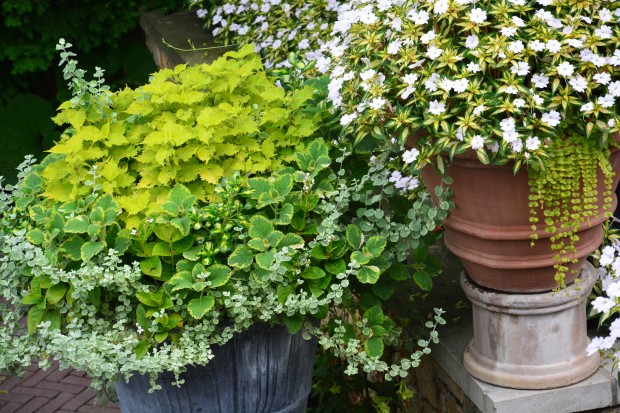 Plants in annual contrainers should be planted with an eye to the eventual overall shape. The lower pots do not have a vertical growing centerpiece. This pot looks like a big salad-delicious enough to eat. Like all of the plants in my landscape, they have appreciated the cooler weather and ample rain. No pouting going on here.
Plants in annual contrainers should be planted with an eye to the eventual overall shape. The lower pots do not have a vertical growing centerpiece. This pot looks like a big salad-delicious enough to eat. Like all of the plants in my landscape, they have appreciated the cooler weather and ample rain. No pouting going on here.
 This planting looks good with my butterburrs, the Princeton Gold maples in the background, and hosta behind me. The choice of plants for these containers has a lot to do with the plants in the vicinity. The drive court is large; the plant palette is limited to the moss between the bricks. These green plants recall and reinforce the overall landscape.
This planting looks good with my butterburrs, the Princeton Gold maples in the background, and hosta behind me. The choice of plants for these containers has a lot to do with the plants in the vicinity. The drive court is large; the plant palette is limited to the moss between the bricks. These green plants recall and reinforce the overall landscape.
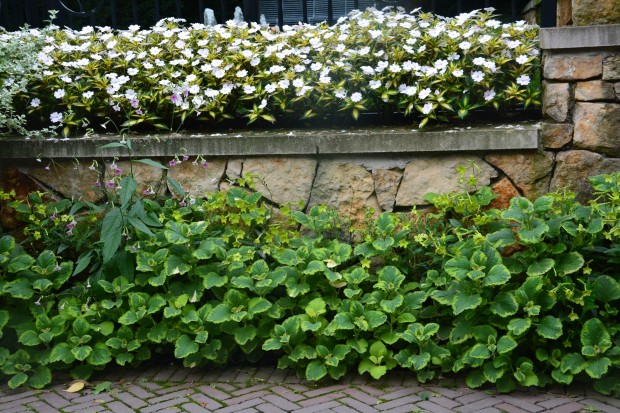 An errant nicotiana mutabilis in a sea of green and gold plectranthus, and some nicotiana alata lime has a few pink flowers. Should it grow strongly over the fall, I doubt I will mind the interruption. A plant that would breach the strongly horizontal lines would be welcome.
An errant nicotiana mutabilis in a sea of green and gold plectranthus, and some nicotiana alata lime has a few pink flowers. Should it grow strongly over the fall, I doubt I will mind the interruption. A plant that would breach the strongly horizontal lines would be welcome.
 In a spot where five different hard materials come together-the wall stone, the limestone cap, the wood, the wall brick, and the driveway brick – the repetition of a limited number of plants is a softening gesture.
In a spot where five different hard materials come together-the wall stone, the limestone cap, the wood, the wall brick, and the driveway brick – the repetition of a limited number of plants is a softening gesture.
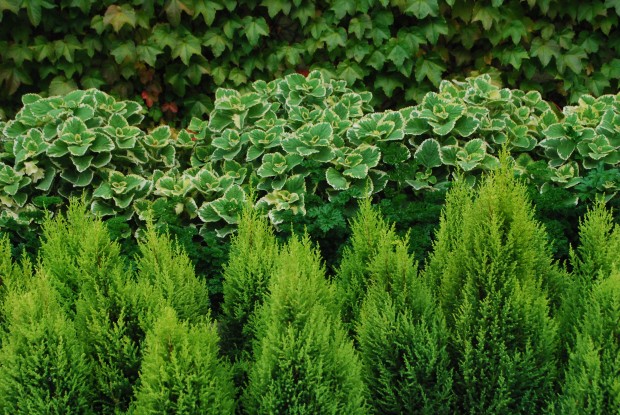 Greens done well are hard to beat. The three plants in the above picture, though formally arranged in rows, contrast in shape, surface, form, mass and texture. Variation on a green color scheme provide plenty of visual interest.
Greens done well are hard to beat. The three plants in the above picture, though formally arranged in rows, contrast in shape, surface, form, mass and texture. Variation on a green color scheme provide plenty of visual interest.
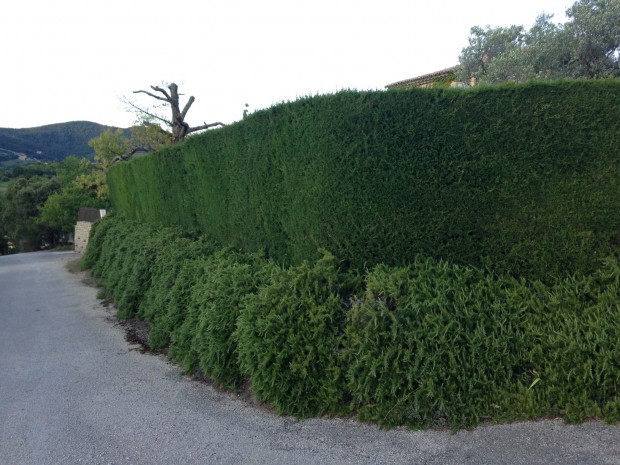 A friend traveling in France a month ago sent me this picture of a formally pruned juniper hedge, under planted with a skirt of trailing rosemary. The pairing of two needle-foliaged plants of very similar color and form is taken to another dimension all together by a decision to selectively prune. There is a gardener with a point of view at work here. The elements of good design may begin with the shapes of spaces, and architectural elements, but a green vocabulary never hurts.
A friend traveling in France a month ago sent me this picture of a formally pruned juniper hedge, under planted with a skirt of trailing rosemary. The pairing of two needle-foliaged plants of very similar color and form is taken to another dimension all together by a decision to selectively prune. There is a gardener with a point of view at work here. The elements of good design may begin with the shapes of spaces, and architectural elements, but a green vocabulary never hurts.

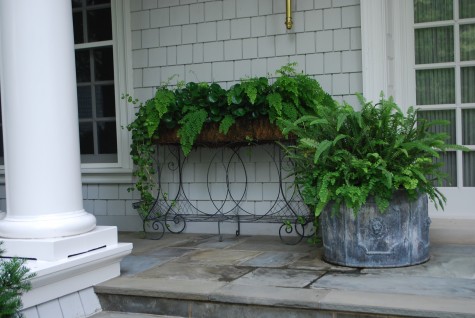
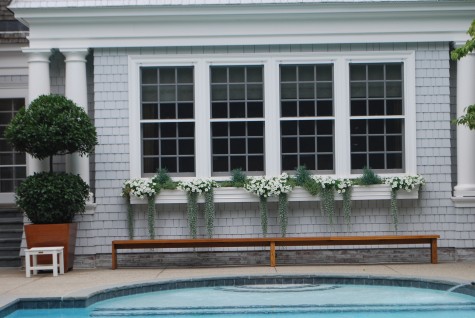


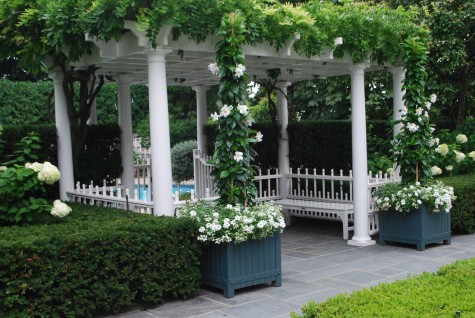
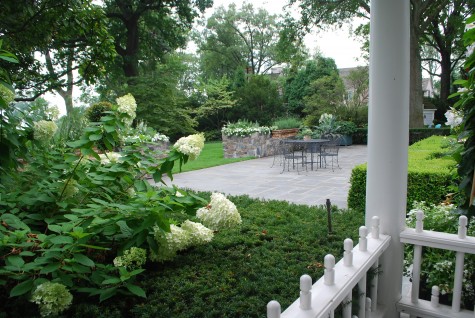


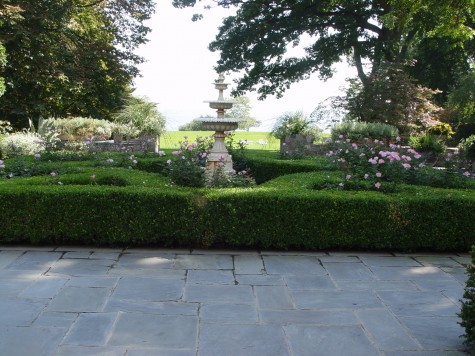 I have clients whose interest in gardens runs to green, and more green. Though my love for the green of the plant is every bit as great as my love for their flowers, I have never had the discipline it takes to restrict my own palette like this. But I find that whenever a client represents their own point of view outdoors, the result looks just right.
I have clients whose interest in gardens runs to green, and more green. Though my love for the green of the plant is every bit as great as my love for their flowers, I have never had the discipline it takes to restrict my own palette like this. But I find that whenever a client represents their own point of view outdoors, the result looks just right.  These large stone and brick piers punctuate a pair of walls that partially enclose a terrace. I plant them with a mix of plants whose textures are as unlike stone and brick as possible. This is a matter of directing visual attention. The window boxes on the roof of my shop are not so gorgeous. They are made of galvanized sheet metal ordinarily used in the production of ductwork for the heating and cooling industry. The sole function of those boxes is to hold the soil, nutrients and water for the plants-they have no visual interest in and of themselves. The intent here is to acknowledge the beautiful surface of the container as much as the planting.
These large stone and brick piers punctuate a pair of walls that partially enclose a terrace. I plant them with a mix of plants whose textures are as unlike stone and brick as possible. This is a matter of directing visual attention. The window boxes on the roof of my shop are not so gorgeous. They are made of galvanized sheet metal ordinarily used in the production of ductwork for the heating and cooling industry. The sole function of those boxes is to hold the soil, nutrients and water for the plants-they have no visual interest in and of themselves. The intent here is to acknowledge the beautiful surface of the container as much as the planting.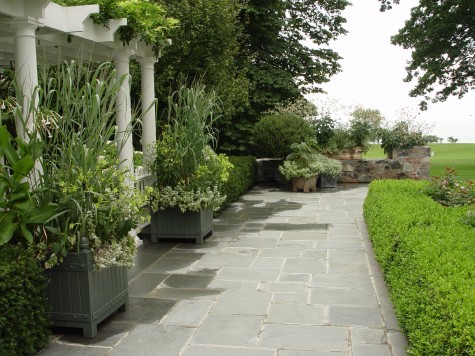 A green planting has a quiet and serene look, as the greens so closely relate in color and value. The green of these painted Belgian oak boxes harmonizes with the color of the bluestone terrace; the relationship is a subtle one. The Dallas Blues panic grass repeats that color. Monochromatic color schemes tend to read that way, although an ocean of orange is anything but serene. Add some contrasting purple to that orange, which in turn contrasts with the green, and you have a visual party going on. These greens speak softly.
A green planting has a quiet and serene look, as the greens so closely relate in color and value. The green of these painted Belgian oak boxes harmonizes with the color of the bluestone terrace; the relationship is a subtle one. The Dallas Blues panic grass repeats that color. Monochromatic color schemes tend to read that way, although an ocean of orange is anything but serene. Add some contrasting purple to that orange, which in turn contrasts with the green, and you have a visual party going on. These greens speak softly.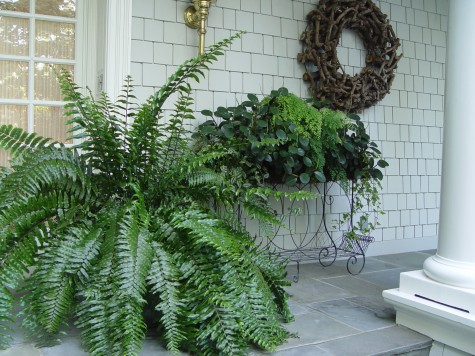 A porch planting plays the spiky texture of a tropical fern off the round chubby leaves of a of large scale pepperomia; the effect is pleasing, not demanding. The elegant English wirework planter reminiscent of vintage conservatory furniture is balanced with a simple and very rustic wreath that hangs on the wall year round.
A porch planting plays the spiky texture of a tropical fern off the round chubby leaves of a of large scale pepperomia; the effect is pleasing, not demanding. The elegant English wirework planter reminiscent of vintage conservatory furniture is balanced with a simple and very rustic wreath that hangs on the wall year round. The container collection is a beautiful one. An American stoneware grape panel container from the 1920’s, and English lead and the Belgian oak box are very different in materials and forms, but very much alike in feeling.
The container collection is a beautiful one. An American stoneware grape panel container from the 1920’s, and English lead and the Belgian oak box are very different in materials and forms, but very much alike in feeling.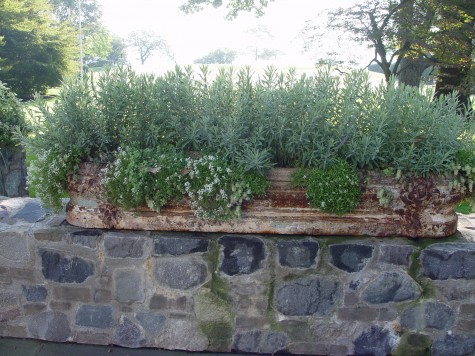 A pair of very old and distinctive French iron planters sit on the walls. I usually plant them with lavender, and alyssum, showy oregano, and whatever other herb like plant seems appropriate. The effect is graceful; the muted colors of every aspect of this space invite contemplation.
A pair of very old and distinctive French iron planters sit on the walls. I usually plant them with lavender, and alyssum, showy oregano, and whatever other herb like plant seems appropriate. The effect is graceful; the muted colors of every aspect of this space invite contemplation.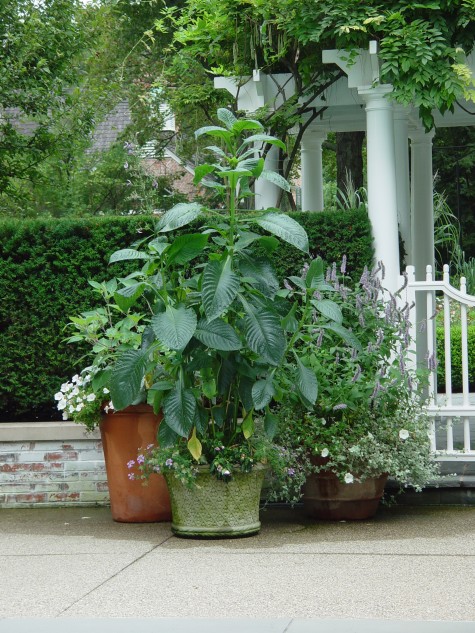 Some plants stay green all season, as our summer is too short to permit flowering-as in this large tropical salvia. The fine perennial hyssop hangs on to the ghostly lavender of its flowers a very long time; this is repeated in a lavender trailing verbena. Though there is some color here, it is the relationships of the greens that reads first and foremost.
Some plants stay green all season, as our summer is too short to permit flowering-as in this large tropical salvia. The fine perennial hyssop hangs on to the ghostly lavender of its flowers a very long time; this is repeated in a lavender trailing verbena. Though there is some color here, it is the relationships of the greens that reads first and foremost. I think the leaves of tibouchina grandiflora are surely my favorite. The large oval leaves are completely covered in fine white hairs; they are a marvel. Their contrast to the needles of the rosemary topiary is considerable in form, and little in color. Variegated licorice is one of the most versatile of all green plants. The leaves sport two different shades of green; the blotches are very blue green, while the edges are more yellow-green. It works with every plant with which it is paired. This collection of pots benefits from the lively effect of its habit of growth, and relative lightness. Subtle does not mean sleepy.
I think the leaves of tibouchina grandiflora are surely my favorite. The large oval leaves are completely covered in fine white hairs; they are a marvel. Their contrast to the needles of the rosemary topiary is considerable in form, and little in color. Variegated licorice is one of the most versatile of all green plants. The leaves sport two different shades of green; the blotches are very blue green, while the edges are more yellow-green. It works with every plant with which it is paired. This collection of pots benefits from the lively effect of its habit of growth, and relative lightness. Subtle does not mean sleepy.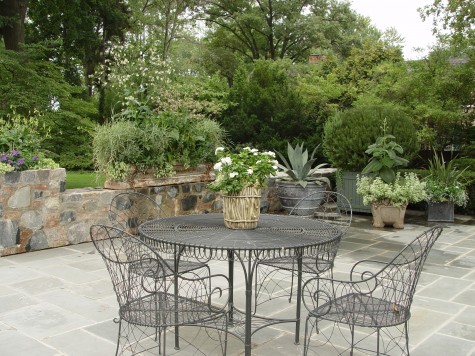
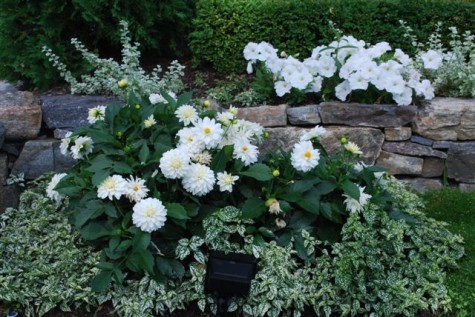
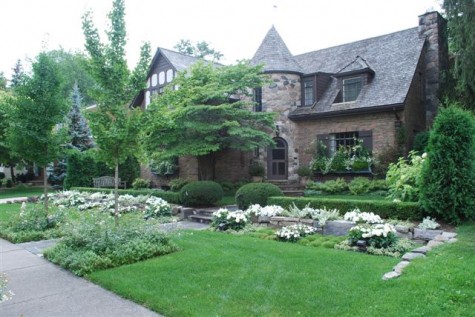 These clients have lived many years in a lovely old Tudor style house built in the 1920’s. However, they both have a love for clean, modern and edited lines. Working with them has produced a garden that has elements both friendly to the architecture of the house, and their point of view. They were both clear that a green and white garden would suit them best.
These clients have lived many years in a lovely old Tudor style house built in the 1920’s. However, they both have a love for clean, modern and edited lines. Working with them has produced a garden that has elements both friendly to the architecture of the house, and their point of view. They were both clear that a green and white garden would suit them best. 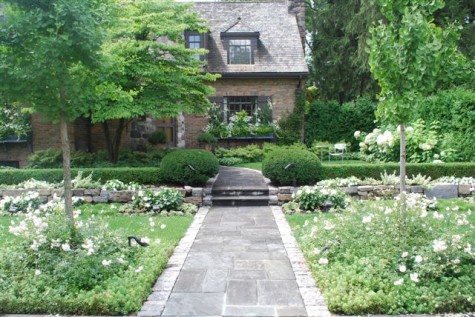 The landscape of the front of the house was already in place when I met them. My input involved the sizes of the flower beds, and the construction and installation of the window boxes. The profusion of flowers is decidedly English in feeling, but the green and white has a crisply contemporary flavor. The strong, dark green horizontal line of the boxwood hedge contrasts and compliments the mass of the oval yews. This element is balanced by the four columnar gingkos that frame the walk at the street. The simple steel windowbox is a focal point at the visual end of the walk.
The landscape of the front of the house was already in place when I met them. My input involved the sizes of the flower beds, and the construction and installation of the window boxes. The profusion of flowers is decidedly English in feeling, but the green and white has a crisply contemporary flavor. The strong, dark green horizontal line of the boxwood hedge contrasts and compliments the mass of the oval yews. This element is balanced by the four columnar gingkos that frame the walk at the street. The simple steel windowbox is a focal point at the visual end of the walk. 
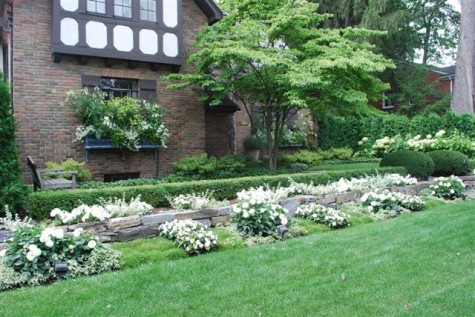 The upper level is planted more freely, with variegated licorice, white petunias and more polka dots. This bedding plant scheme derives more visual interest from its texture and layout than from the plant species.
The upper level is planted more freely, with variegated licorice, white petunias and more polka dots. This bedding plant scheme derives more visual interest from its texture and layout than from the plant species.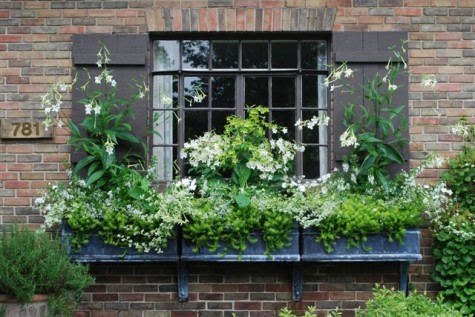 The window boxes are lush with green angelina, euphorbia, and licorice. The angular nicotiana alata white frames the more orderly growing Perfume nicotiana series in white and lime green.
The window boxes are lush with green angelina, euphorbia, and licorice. The angular nicotiana alata white frames the more orderly growing Perfume nicotiana series in white and lime green.
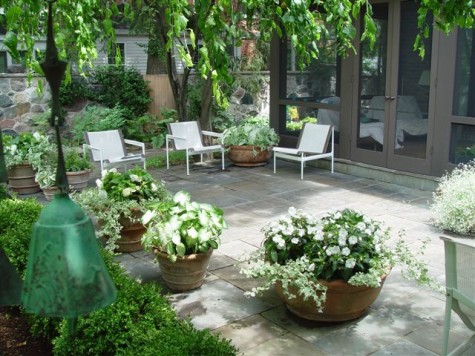
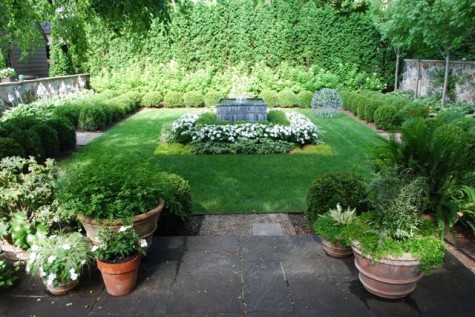 A custom made steel cistern positioned on axis to the porch, and the side walk organizes the space. It was constructed with legs tall enough to hide the fountain pump, but also to provide for the eventual height of the boxwood surrounding it. Bordered in boxwood, a run of limelight hydrangeas provides another level of interest against the green arborvitae wall.
A custom made steel cistern positioned on axis to the porch, and the side walk organizes the space. It was constructed with legs tall enough to hide the fountain pump, but also to provide for the eventual height of the boxwood surrounding it. Bordered in boxwood, a run of limelight hydrangeas provides another level of interest against the green arborvitae wall.
